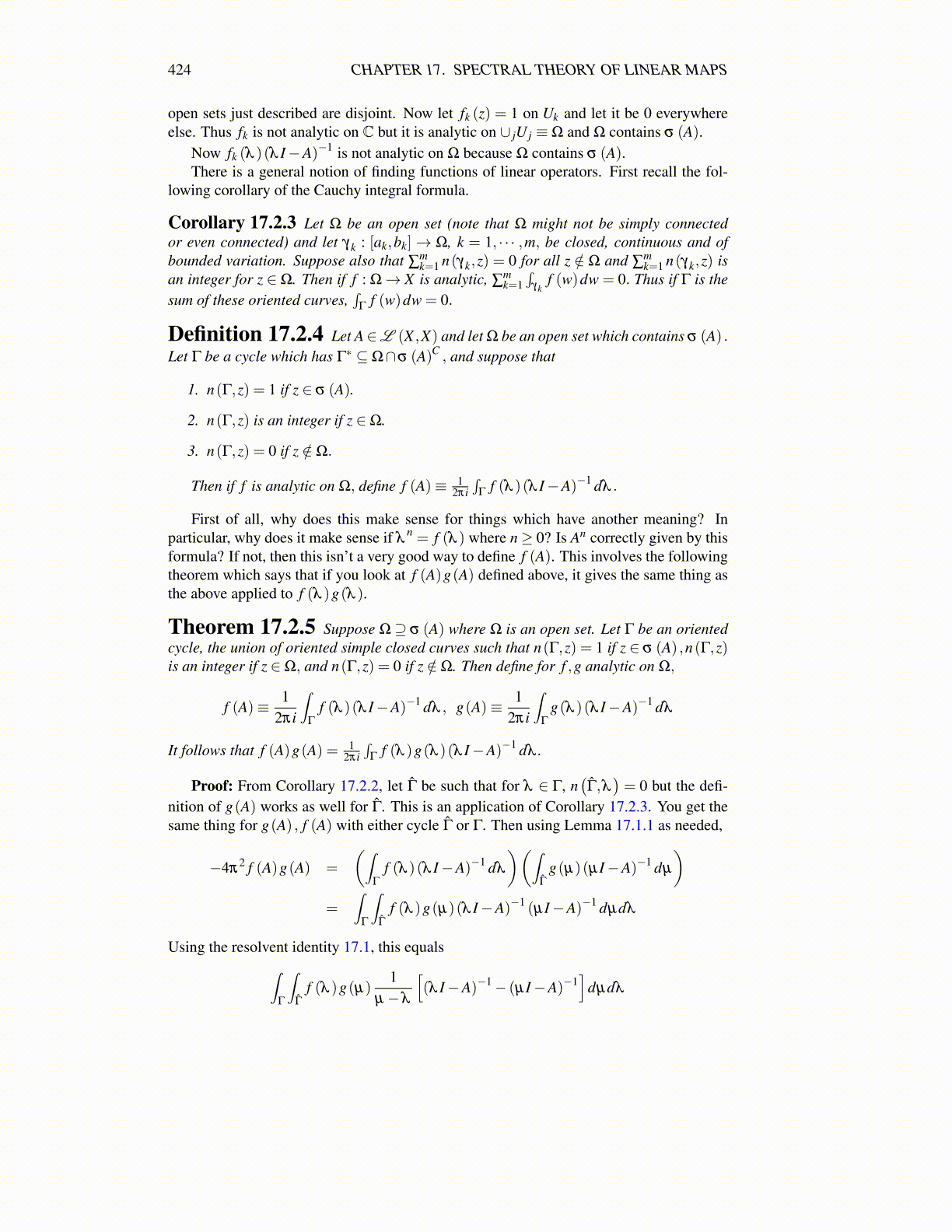
424 CHAPTER 17. SPECTRAL THEORY OF LINEAR MAPS
open sets just described are disjoint. Now let fk (z) = 1 on Uk and let it be 0 everywhereelse. Thus fk is not analytic on C but it is analytic on ∪ jU j ≡Ω and Ω contains σ (A).
Now fk (λ )(λ I−A)−1 is not analytic on Ω because Ω contains σ (A).There is a general notion of finding functions of linear operators. First recall the fol-
lowing corollary of the Cauchy integral formula.
Corollary 17.2.3 Let Ω be an open set (note that Ω might not be simply connectedor even connected) and let γk : [ak,bk]→ Ω, k = 1, · · · ,m, be closed, continuous and ofbounded variation. Suppose also that ∑
mk=1 n(γk,z) = 0 for all z /∈ Ω and ∑
mk=1 n(γk,z) is
an integer for z ∈Ω. Then if f : Ω→ X is analytic, ∑mk=1
∫γk
f (w)dw = 0. Thus if Γ is thesum of these oriented curves,
∫Γ
f (w)dw = 0.
Definition 17.2.4 Let A∈L (X ,X) and let Ω be an open set which contains σ (A) .Let Γ be a cycle which has Γ∗ ⊆Ω∩σ (A)C , and suppose that
1. n(Γ,z) = 1 if z ∈ σ (A).
2. n(Γ,z) is an integer if z ∈Ω.
3. n(Γ,z) = 0 if z /∈Ω.
Then if f is analytic on Ω, define f (A)≡ 12πi∫
Γf (λ )(λ I−A)−1 dλ .
First of all, why does this make sense for things which have another meaning? Inparticular, why does it make sense if λ
n = f (λ ) where n≥ 0? Is An correctly given by thisformula? If not, then this isn’t a very good way to define f (A). This involves the followingtheorem which says that if you look at f (A)g(A) defined above, it gives the same thing asthe above applied to f (λ )g(λ ).
Theorem 17.2.5 Suppose Ω⊇ σ (A) where Ω is an open set. Let Γ be an orientedcycle, the union of oriented simple closed curves such that n(Γ,z) = 1 if z ∈ σ (A) ,n(Γ,z)is an integer if z ∈Ω, and n(Γ,z) = 0 if z /∈Ω. Then define for f ,g analytic on Ω,
f (A)≡ 12πi
∫Γ
f (λ )(λ I−A)−1 dλ , g(A)≡ 12πi
∫Γ
g(λ )(λ I−A)−1 dλ
It follows that f (A)g(A) = 12πi∫
Γf (λ )g(λ )(λ I−A)−1 dλ .
Proof: From Corollary 17.2.2, let Γ̂ be such that for λ ∈ Γ, n(Γ̂,λ
)= 0 but the defi-
nition of g(A) works as well for Γ̂. This is an application of Corollary 17.2.3. You get thesame thing for g(A) , f (A) with either cycle Γ̂ or Γ. Then using Lemma 17.1.1 as needed,
−4π2 f (A)g(A) =
(∫Γ
f (λ )(λ I−A)−1 dλ
)(∫Γ̂
g(µ)(µI−A)−1 dµ
)=
∫Γ
∫Γ̂
f (λ )g(µ)(λ I−A)−1 (µI−A)−1 dµdλ
Using the resolvent identity 17.1, this equals∫Γ
∫Γ̂
f (λ )g(µ)1
µ−λ
[(λ I−A)−1− (µI−A)−1
]dµdλ